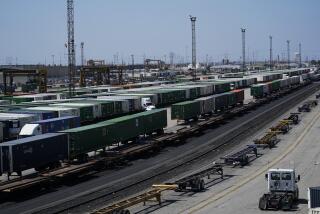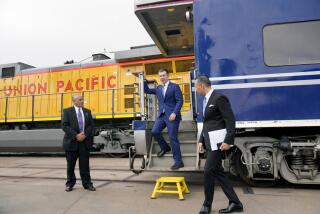Clear the tracks for new port rail yard
The ports of Los Angeles and Long Beach are a powerful economic engine for Southern California. They produce more jobs than the entire movie business, and they connect the United States to ports across the Pacific Ocean. The hundreds of billions of dollars’ worth of goods that pass through them are an essential source of economic livelihood, and yet at times the ports impose a burden on those who live closest to them, forcing policymakers to weigh what is best for the nation and the region against what harm it might do to neighbors. In the case of a proposed rail loading facility known as the Southern California International Gateway, the vast benefits — environmental as well as economic — clearly outweigh the downside. The L. A. Board of Harbor Commissioners has approved the project; the City Council should follow suit.
That recommendation is not made with indifference to those who live, work or go to school near the proposed rail switching yard, which would be built by BNSF Railway. They are understandably apprehensive about a project that would bring an endless stream of trucks into the yard, where they would discharge their cargo onto rail cars. That facility would operate 24 hours a day, and the traffic, noise, lights and, most importantly, the potentially harmful air pollution are naturally sources of concern to its neighbors in the Wilmington area, many of them working-class people. Lower-income communities too often bear the brunt of progress, and policy makers need to do a better job protecting them and distributing the burdens of growth. As this project progresses, lawmakers must ensure that its effects are minimized or mitigated.
Still, there are clear benefits to this particular project, some of which accrue to the immediate neighborhood. The trucks that would deposit their cargo at the new yard today rumble along those same streets as they’re driven from the port complex to the existing switching yard 24 miles to the north on the 710 Freeway. If this project is approved, that trip would be shortened to four miles and would produce fewer overall emissions. It is also worth noting that this already is a highly industrialized area, and that even the residents closest to this project live on the other side of the 710 Freeway.
The new yard would allow only trucks built after 2010 — which are cleaner than the older vehicles that currently pass through the area. What’s more, by 2023, 75% of the trucks using the yard would have to be powered by natural gas or equivalently clean sources, increasing to 90% by 2026. Trucks would be routed away from homes as much as possible; the company has promised to monitor that by GPS.
Is more mitigation possible? Long Beach Mayor Bob Foster has a list of reasonable measures that Los Angeles lawmakers should consider. He wants businesses that are displaced to be relocated, a planted buffer to help protect residents from particulates, a long-term commitment to zero-emission technology and a fund to help residents install filters or other devices to protect them from any increased pollution.
The debate over this project has been exhaustive, stretching over eight years, and has become a symbol of Los Angeles’ inability to grow its economy. On the other hand, thanks partly to the efforts of the Natural Resources Defense Council and neighborhood groups, the company has made significant concessions. Indeed, although many residents don’t believe it, the environmental impact report actually predicts that the threats to the community will decrease if the yard is built under the current agreement, in part because air quality overall will improve.
Meanwhile, the benefits to the region are undeniable. The yard would take 1.5 million truck trips every year off the 710 Freeway, eliminating congestion and air pollution. It would create 1,500 jobs during construction and, once in operation, thousands more.
The perfect solution would be for cranes to move boxcars directly to and from the ships and trains, obviating the need for trucks. That’s already the case at some of the complex’s piers, and leaders should, as budgets allow, build more of those very expensive “on-dock” loading facilities. Someday, yards such as the Gateway may be obsolete. In the meantime, however, this project will produce badly needed jobs and a cleaner environment. The City Council should approve it, and construction should begin.
More to Read
A cure for the common opinion
Get thought-provoking perspectives with our weekly newsletter.
You may occasionally receive promotional content from the Los Angeles Times.










